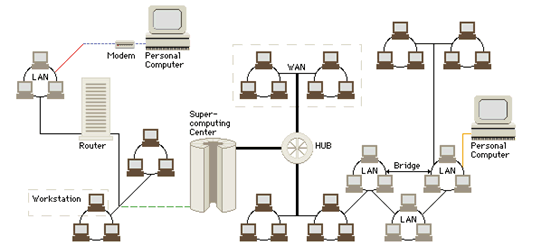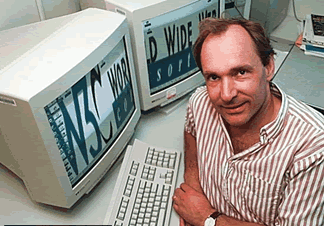I Introduction
World Wide Web (WWW), computer-based network of information resources that combines text and multimedia. The information on the World Wide Web can be accessed and searched through the Internet, a global computer network. The World Wide Web is often referred to simply as “the Web.”

The Web started to become a popular resource after 1993 when the first widely distributed browser provided a convenient way to access a variety of information on the Internet. The Web uses multimedia, which means that information can be displayed in a wide variety of formats. Users can read text, view pictures, watch animation, listen to sounds, and even explore interactive virtual environments on the Web. A user can move seamlessly from a document or Web page stored on the computer to a document or Web page stored on another computer.
The Web offers a place where companies, universities and other institutions, and individuals can display information about their products, services, facilities, or research, or their private lives. Only a small percentage of information on the Web is restricted to subscribers or other authorized users. The majority of Web pages are available to anyone who can access a computer that connects to the Internet. The Web has become a marketplace for many companies selling products or services, and a forum for people to exchange opinions and information. Museums, libraries, government agencies, and schools post information on the Web to make it available to others.
II A WEB OF COMPUTERS
All communication on the Web is carried out among a set of computers that are interconnected by a computer network. Web technology can be used across an intranet (a network within a company or organization) or across the global Internet. As with all communications among computers, computers that comprise the Web employ two types of software: client and server (see Client/Server Architecture). To make information available, a computer runs a server program. To obtain and display information from a server, a computer user runs a client program. The client contacts a server to request information; the server responds by sending a copy of the requested information. To ensure that the exchange is meaningful, the client and server programs must follow a communication protocol, a set of rules that the two programs use to talk to one another. Like a language, a protocol specifies both the form and meaning of each possible message.

In principle, any computer can run a client or a server. In practice, however, large, powerful computers are usually chosen to run server software, and small personal computers (PCs) are sufficient to run client software. Powerful computers are chosen for server software because they must be able to handle requests for information from millions of people and do so quickly so that users who request information from the server will not experience long delays. PCs, however, are used by a single person to request a Web page. After a user makes a request, the user waits for the information to be displayed. Thus, the client program running on a user's computer only needs to handle one activity at a time. A server, however, must handle simultaneous requests from many clients, possibly millions.
The difference between the Web and the Internet is similar to the difference between a trucking service and a highway system. The Internet corresponds to a highway that allows traffic to flow between computers, and the Web corresponds to a service that uses the highway to move information from one computer to another. Confusion about the difference between the Web and the Internet has arisen because the Web has become extremely popular and currently accounts for the majority of Internet traffic. However, other services also use the Internet to carry their traffic. For example, the Internet's electronic mail service permits users to send and receive textual messages, and the file transfer service allows a user to transfer a copy of a file from one computer to another.
Although many services use the Internet to carry data from one computer to another, each service follows a separate set of rules that define the messages used in the exchange. The Web uses the HyperText Transfer Protocol (HTTP), electronic mail uses the Simple Mail Transfer Protocol (SMTP), and file transfer uses the File Transfer Protocol (FTP). The application programs that users run to access the Internet often blur the distinction among these services. For example, an application program that can send e-mail also allows a user to transfer the contents of a file, and an application program used to access the Web also allows the user to process e-mail.
III History
 The World Wide Web was developed by British physicist and computer scientist Timothy Berners-Lee as a project within the European Organization for Nuclear Research (CERN) in Geneva , Switzerland . Berners-Lee combined several existing ideas into a single system to make it easier for physicists to use data on the Internet. Most important, he added multimedia—the ability to include graphics—to the hyperlink concept found in a previous Internet service known as gopher. Berners-Lee had begun working with hypertext in the early 1980s. An early prototype implementation of the Web became operational at CERN in 1989, and the idea quickly spread to universities in the rest of the world.
The World Wide Web was developed by British physicist and computer scientist Timothy Berners-Lee as a project within the European Organization for Nuclear Research (CERN) in Geneva , Switzerland . Berners-Lee combined several existing ideas into a single system to make it easier for physicists to use data on the Internet. Most important, he added multimedia—the ability to include graphics—to the hyperlink concept found in a previous Internet service known as gopher. Berners-Lee had begun working with hypertext in the early 1980s. An early prototype implementation of the Web became operational at CERN in 1989, and the idea quickly spread to universities in the rest of the world.
Groups at the National Center for Supercomputing Applications at the University of Illinois at Urbana-Champaign researched and extended Web technology. They developed the first browser that was used at many sites, named Mosaic, in 1993. To allow the Web to be accessed from a wide variety of computer systems, researchers built multiple versions of Mosaic. Each version was designed to be used with a specific operating system, the software that controls the computer. Within a year, computer programmer Marc Andreessen had formed a commercial company, Netscape Communications Corporation, to build and sell Web technologies.
Microsoft Encarta Reference Library 2005. 1993-2004 Microsoft Corporation.